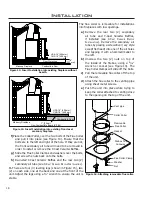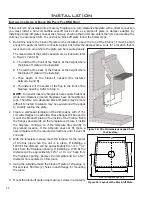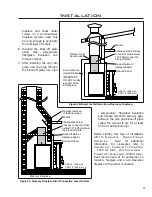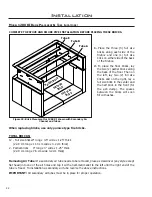
Operating Instructions
2. Building/Maintaining a Fire:
a) Open the primary air slide by pulling it all the way to the right.
b) Place a base of crumpled uncolored paper in the bottom of the stove. Lay pieces of kindling on top of
the newspaper and light it.
CAUTION: “Never use gasoline, gasoline-type lantern fuel, kerosene, charcoal lighter fluid,
or similar liquids to start or “freshen up” a fire in this heater. Keep all such liquids well
away from heater while it is in use.
c) As the kindling begins to burn, add several slightly larger pieces of wood until the fire is burning well.
Once a coal bed had been established regular size logs may be added.
NOTE:
Until the fire is burning well, leave the air control fully open.
d) Regulate the heat output and duration of burn by adjusting the air controls to allow a larger fire and
vice versa. A short period of experimentation with the control settings will allow you to regulate the
heat output to keep your home comfortable.
Do not use a grate or elevate the fire. Build fire on top the bricks inside the firebox.
3. Refueling the Stove:
Use a long pair of gloves (barbecue gloves) when feeding the fire because these stoves burn at the front.
They are clean and efficient but they are also very hot and gloves are useful. Keep a small steel shovel
and whisk nearby for moving a log or lifting a fallen ember and for keeping the hearth clean.
a) Before attempting to add fuel to the stove, OPEN the damper control fully by pulling it all the way out.
This allows the chimney to carry away the additional smoke, which occurs when the door is open.
b)
DO NOT OVERLOAD THE STOVE.
Normally, three or four logs will provide heat for several hours.
Never operate this stove where portions glow red hot. Using more than five logs at a time can cause
overfiring. Keep logs a few inches from the lowest point of the top of the firebox. If any logs are touching
the tubes in the top of the firebox, you can damage the air tubes. Overloading the stove can cause
damage to the firebox and air tubes and will void the warranty.
c)
DO NOT OVERFIRE
. If the heater or chimney connector glows, you are overfiring. If the stove top
temperatures exceed 550°F, you are overfiring. Overfiring your stove will void the warranty.
d)
WHAT IS OVERFIRING?
Overfiring is when the stove is generating too much heat in the firebox,
causing parts within your stove to glow red and warp. To spot overfiring, place a thermometer on the
stove top. If the stove top temperatures exceed 550°F, you are overfiring. Another way to spot overfiring
is if the heater or chimney connector glows.
e)
CAUTION:
DO NOT PLACE FUEL OR COMBUSTIBLE MATERIAL WITHIN SPACE HEATER INSTALLATION
CLEARANCES OR WITHIN THE SPACE REQUIRED FOR CHARGING AND ASH REMOVAL. LOGS SHOULD BE
KEPT IN A BIN OR CONTAINER TO REDUCE THE RISK OF LOGS ROLLING INTO THE UNIT’S CLEARANCES.
f)
HOW TO AVOID OVERFIRING:
To avoid overfiring, do not overfill your firebox. Usually a maximum
of four logs at a time is sufficient enough to avoid overfiring. Keeping stove top temperatures under
550°F will also prevent overfiring.
g)
KEEP THE ASH LIP CLEAR OF EMBERS AND ASH
. If the door is closed with debris in the way,
the door gasket seal could be compromised.
h)
CAUTION:
DO NOT PLACE FUEL WITHIN SPACE HEATER INSTALLATION CLEARANCES OR WITHIN
THE SPACE REQUIRED FOR ASH REMOVAL.
4. For Maximum Efficiency:
When the stove is hot, load it fully to the top of the door opening and burn at medium low settings. When
the fuel is mostly consumed, leaving a bed of red coals, repeat the process. Maximum heat for minimum
fuel occurs when the stove top temperature is between 250°F (120°C) and 550°F (290°C).
7
Summary of Contents for Kodiak 1200 FPI
Page 30: ...Notes 30 ...






















